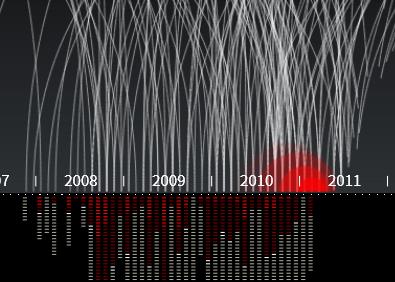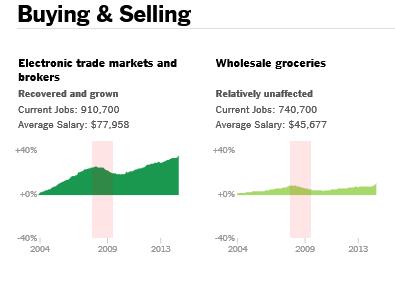VISUAL DISCOURSE
Animation has been a traditional tool of storytelling and visual discourse for a long time, hence the abundance of examples both in traditional animation and computer-generated material. We identi-fied four roles of animations for discourse purpose.
Supporting a narrative
Animation supports narrative by providing progressive disclosure of arguments and transition smoothly between them.
Segel, E., & Heer, J. (2010). Narrative visualization: Telling stories with data. In IEEE TVCG, 16(6), 1139-1148.
Pitch interactive developed a powerful online narrative visualization documenting every drone strike carried out in Pakistan. Animation is first used to introduce the topic, disclosing progressively the layout elements of the display to pace the story. Finally, the visualization of the drone attacks over time and their casualty. It included clickable links where animation is used to transition from current display to the next.
Scrolling is also commonly used to activate a transition to a next step of the story e.g. in “How the Recession Reshaped the Economy, in 255 Charts” —New York Times.
“Fallen of World War II” is an interactive documentary that examines the human cost of the second world war. The animation follows a linear narration, but it allows viewers to pause during key moments to interact with the charts and dig deeper into the numbers.
Highlighting content
Motion has a strong attention-drawing power, and can be used to highlight or emphasize content.
For example, an animation making a set of bar in a chart jump when the narrator is discussing them is used in the data video depicting Wealth Inequality in America. Animation featuring icons moving along a line chart can also serve to emphasize an increasing or decreasing trend. Animation of objects or text blinking, jumping or getting larger are also commonly featured in presentation tools such as PowerPoint.
Persuading, convincing
Animation can be used to make a particular point across with the intent to persuade or convince its viewer.
The Guardian published a story aimed at convincing people to vaccination their children by illustrating alternative scenarios using an animation. This animation shows how disease spreads on hypo-thetical populations of children whether she is vaccinated (blue) or not (yellow). An infected person regularly shows up and enters in contact with a child: a red circle flies over and bumps into a child in one of the populations, and may or may not infect the child. A vulnerable child (yellow) will automatically turn red at the contact of the red circle, and the flu will spread to all surrounding vulnera-ble children. Different populations show the impact of vaccination rates, the argument being that immunizing a child does not only protect the child, “immunization is contributing to the control of the disease in the population”.when individuals enter in contact with an infected person.


